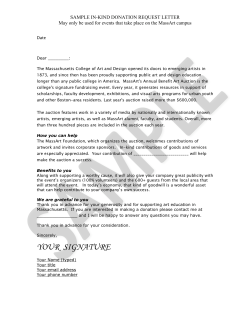
A1. (i) Explain what it means to say that bidders’... ascending or first-price sealed-bid auctions more profitable in this circumstance?
A1. (i) Explain what it means to say that bidders’ private signals are affiliated. Are ascending or first-price sealed-bid auctions more profitable in this circumstance? What is the intuition for this result? (ii) Each of risk-neutral bidders has a privately-known value for a single object. For each , = + in which the are independently drawn from a uniform distribution on [0,1], but bidders have a “diffuse prior” for (that is, all values of are equally likely,1 and bidder knows only , not or ). The seller’s value of the object is . (a) What is the seller’s profit from an ascending auction? (b) What is the seller’s profit from a first-price sealed-bid auction? [Note that each bidder bids − for some , since the ‘diffuse prior’ assumption means she has no knowledge of how high or low her value is relative to others’.] (iii) Repeat (ii)(a) and (b) under the assumption that is common knowledge to all bidders (but remains private information to bidder ). Explain why the answers to (ii)(b) and (iii)(b) are different. (iv) Repeat (ii)(a) and (b) under the assumption that all the are common knowledge to all bidders. (v) Describe how the results of (ii), (iii), and (iv) would change qualitatively if the were affiliated. [Oxford, Economic Theory, 2004] A2. (i) Sketch a proof of the Revenue Equivalence Theorem. (ii) For each of the following cases, briefly discuss why the theorem can break down and the extent (if any) to which the theorem applies. (a) Bidders’ signals are not independent. (b) Bidders are risk-averse. (c) Bidders can collude. (d) The seller has multiple units for sale. (e) The distribution from which bidders’ valuations are drawn is not both strictly-increasing and atomless. [Oxford, Economic Theory, 2004] 1 Formally can be thought of as uniformly distributed on [− +] in the limit as → ∞. A3. Risk-neutral bidders = 1 2 each receive a private signal independently drawn from a uniform distribution on [0 1]. Both bidders have the same value for an object, = 1 + 2 . (i) Assume the object is sold by English (i.e. Japanese, or ascending) auction. Compute symmetric equilibrium bidding strategies. (ii) Assume the object is sold by Dutch (i.e. descending) auction. Use your solution in (i) together with the Revenue Equivalence Theorem to deduce equilibrium bidding strategies. (iii) Assume the object is sold by an All-pay auction (in which each bidder pays her bid whether or not she wins). Use your solution in (i) together with the Revenue Equivalence Theorem to deduce equilibrium bidding strategies. (iv) Solve for the (symmetric) All-pay equilibrium strategies directly, by writing out ’s surplus when her signal is and she bids as if her type were e, and then obtaining a differential equation from the first-order condition. (v) If now bidder 1’s value is = 1 + 2 + 001 (but bidder 2’s value is unchanged), what happens in the ascending auction? Can we use the Revenue Equivalence Theorem to compute the Dutch auction’s outcome from the ascending auction’s outcome? Why or why not? [Oxford, 1st Year Micro, 2004] A4. Risk-neutral bidders = 1 4 each receive a private signal independently drawn from a common distribution (·) and compete for two objects, each of value = 4 X . Each bidder can win at most one object. Write () for the ith highest =1 actual signal. (i)(a) Describe symmetric equilibrium bidding strategies when both objects are sold in a single ascending auction (i.e., the price rises continuously until just two bidders remain; the remaining bidders each win one object at the final price). (b) Describe symmetric equilibrium bidding strategies when the bidders are randomly divided into two pairs, and each pair competes in a single ascending auction for a single object. (c) Hence compute expected revenue for cases (a) and (b) when () =∙. ¸ (ii)(a) Give a condition in terms of “marginal revenues” () ≡ − 1− (() ) (() ) (since () = 1 here) such that the sales mechanism of (i)() is more profitable than that of (i)(). (b) Hence (I) confirm your result in (i)(c) about which sales mechanism is more profitable if () = , and (II) determine which sales mechanism is more profitable if () = 1 − −2 , for ≥ 1. (III) For each of these two distributions, (·), which sales mechanisms do bidders prefer? (IV) For each of these two distributions, which sales mechanisms would be more profitable if bidders ’s value was simply = , = 1 4. (c) Comment. [Oxford, Economic Theory 2006] A5. Why is a Vickrey auction often thought a good sales mechanism in theory? Why are they often less desirable in practice? Your answer should consider both single-unit and multi-unit contexts. [Oxford, Economic Theory 2006] A6. Two risk-neutral partners = 1 2 each own 50% of a company. Each partner has a private value, , for the whole company that is drawn independently and identically from the uniform distribution on [0,1]. The partners decide they will run an auction between them, with one partner buying the other out. Assume that the auction will be efficient. (i) Define the expected gross surplus, ( ) of partner as his probability, ( ) of winning the whole firm times his value, , plus any expected payments he receives from his former partner minus any expected payments he makes to the former partner. On average, what is the combined expected gross surplus of the two bidders? How does the per bidder expected surplus compare with the expected per bidder surplus the bidders would receive if they were competing to buy the same asset, but it was owned by a third party? (ii) Assuming bidders do not know their partners’ values, explain carefully why R ( ) = (0) + 0 () Hence obtain a simple expression for ( ) assuming (0) is the same for both partners. (iii) Assuming that the partners make sealed bids, and the high bidder pays his bid to buy out his partner’s share of the firm, obtain an expression for ( ) in terms of each partner’s bid ( ). (Note that efficiency implies that the partners use the same bidding function, so that the bidder with the higher value always wins.) Combine this with your result for part (ii) to show that each partner’s bid ( ) is linear in his value . (iv) If instead the auction is an ascending auction, at what price does a bidder with value quit? Why does each partner always bid up to a price that exceeds his value for the half of the partnership that he is buying (i.e., bid further than 2 )? (v) On average which ”type”, of partner gains least from the dissolution (assume a partner with a 50% share would have a value of 2 if the partnership were not dissolved)? (vi) If partners’ shares were unequal how, if at all, would the analysis be affected? Explain how unequal partners can adjust either of the mechanisms in parts (iii) and (iv) above so that (0) is different for different partners, and hence so that a (somewhat) larger partner is always willing to participate. How unequal can the shares be before efficient dissolution becomes impossible by any mechanism that both partners would agree to, if the partners know their own values before agreeing to a mechanism? [Oxford, Economic Theory, 2007] A7. A magazine recently (slightly mis)quoted an (Oxford) academic as saying (about the outcome of a simultaneous ascending auction) ”Companies that bid for a few large regions to obtain nationwide spectrum paid almost twice as much as firms with the equivalent amount of spectrum assembled from hundreds of licences in smaller areas. This suggests an inefficiency in the auction design, since the same coverage ought to cost the same amount.” (i) What do you think the economist meant to convey by his comments? (ii) What might have caused this outcome? (iii) Is it always true that an auction design that sells identical objects at different prices is an inefficient one? (iv) What determines whether a commodity like spectrum is best sold as a small number of licences each of which covers a large region, or as a large number of licences each of which covers a small part of a region? (v) Does a ”package auction” resolve the problems of both these approaches? [Oxford, Economic Theory, 2007] A8. “The revenue equivalence theorem proves that auction design is irrelevant.” Does it? [Oxford, 1st Year Micro, 2007] A9. (i) How, in theory, can an auction extract all the surplus from risk-neutral bidders when their information is affiliated? (ii) Why might this not work well in practice? (iii) Discuss what recommendations are usually made about how to run an auction in practice when bidders’ information is affiliated. [Oxford, Economic Theory, 2008] A10 (i) A woman has a value drawn from a uniform distribution on [40,80] for an object. A man has a value (independently) drawn from a uniform distribution on [0,40] for the same object. The seller’s valuation for the object is 10. A. Describe an expected-profit maximising auction for the object. B. Describe how the auction could be run as a standard ascending auction, if we give the man a (fixed) discount conditional on him being the winner. C. Explain why discriminating in favour of the man is necessary to maximise expected revenue. (ii) Now assume both bidders’ values are independently drawn from the same distribution, which with probability 20% is uniform on [40,80], and with probability 80% is uniform on [0,40]. As before, the seller’s valuation for the object is 10. A. Explain why expected profit cannot be maximised by an auction that always sells to the higher-value bidder whenever it sells to either bidder, but can be maximised if it does this with the exception that it randomises equally between the bidders when both have values between 35 and 50. What prices should be charged in the latter auction (as a function of the bidders’ values) to maximise expected profit? B. Explain why it would not harm revenue if, instead of randomising equally, the object were always given to the man in the event both bidders’ values were between 35 and 50. What prices should be chosen in this case? [Oxford, Economic Theory, 2008] A11. (i) State the Revenue Equivalence Theorem. (ii) Three risk-neutral firms compete for a single indivisible object which is worth to firm ; = 1 2 3, where each is a (privately-known) independent draw from the uniform distribution on [0 ]. (a) What is the expected payment of the winning firm, if the object is sold using an ascending auction? What is the winner’s expected profit? (b) Assume, instead, that the object is sold in an auction in which firms simultaneously choose bids, . The firm that makes the highest bid wins the object and pays , where 0 Other firms each pay where 0 and win nothing. What is the total of the expected payments made by the three firms? What is the net industry expected profit? (iii) Each of three risk-neutral firms has ”locked in” consumers who will buy from it at any price up to $1. There are also − ”uncommitted” consumers who will all buy from the firm that sets the lowest price, if that price is not more than $1. Each firm’s per unit production cost is a (privately-known) independent draw from the uniform distribution on [0 ] 1 All firms set all prices simultaneously. (a) What is expected industry profit when firms can price discriminate between their customers? (That is, each firm will set price $1 to its own ”locked in” consumers, who will buy from it anyway, and will set a different price to the ”uncommitted” consumers.) (b) Now assume, instead, firms cannot price discriminate between consumers. (That is, each firm must set a price that both applies to its own ”locked in” consumers, who will buy from it anyway, and also applies to the ”uncommitted” consumers.) Explain how this problem can be described as an auction. What is the prize? What are the winner’s and the losers’ payments? What is expected industry profit? (iv) Very briefly, comment on whether the ability to price discriminate against consumers with switching costs necessarily raises a firm’s profits, and give intuition for your answer. [Oxford, 1st Year Micro, 2009] A12. i. Two bidders and compete in an ascending auction to buy a company. ’s actual value is + (1 − ) = 6= ∈ (12 1] in which and are private information to and respectively. a. If follows the strategy of quitting the auction when the price reaches , for some constant , what is ’s optimal strategy? b. Provide intuition for how your result depends upon . c. Find a perfect Bayesian Nash equilibrium of the auction. ii. Now assume that synergies between and its existing assets mean that ’s actual value is ( + (1 − ) ) for some constant 1. (’s actual value is + (1 − ) , as before.) a. What is ’s optimal strategy, if still follows the strategy of quitting the auction at ? b. Show that if (1 − ) then quitting at , = with = (2 − 1)( + − ) = (2 − 1)( + − 1) is a perfect BayesianNash equilibrium. c. Explain what happens as → (1 − ), and why. iii. Assume and are independent draws from the same uniform distribution with lower bound zero. a. By considering the two cases = 1, and large, show that the seller’s expected profits need not be monotonic increasing in . b Without making any more calculations, suggest what possible strategies might raise the seller’s revenue when (1 − ) ≈ 1 [Oxford, Advanced Micro, 2011] A13. Does good auction design depend on whether bidders’ valuations are private or common? Explain why or why not. [Oxford, 1st Year Micro, 2011] A14. (i) Describe how a simultaneous ascending auction (SAA) works. (ii) Give conditions under which an SAA is efficient, and explain why each of your conditions is necessary. (iii) Is an SAA likely to work well under more general conditions? [Oxford, Advanced Micro, 2012] A15. (i) What are the advantages and disadvantages of the Vickrey auction design? (ii) How can it be modified to alleviate its problems? [Oxford, Advanced Micro, 2013] A16.(this was a ”short” question) Each of three students = 1 2 3 has a value, , that is independently drawn from a uniform distribution on [$5, $15], for a bottle of wine, and each student bids independently and non-co-operatively in an auction. (i) as a function of 1 , what is student 1’s optimal bid in a second-price sealed-bid auction? (ii) as a function of 1 , what is the expected gain to student 1 from participating in the auction? (iii) what additional assumption(s) do you need to make for the expected value to student 1 of participating in the auction to be the same as if the auction were a first-price sealed-bid auction? (iv) making the additional assumption(s) made in part (iii), use the Revenue Equivalence theorem to find student 1’s optimal bid as a function of 1 , in a first-price sealed-bid auction? (v) qualitatively, if the additional assumption(s) made in part (iii) did not hold, how would the optimal bid in part (iv) and the associated expected value change? [Oxford, 1st Year Micro, 2013] A17. Consider the following first-price sealed-bid auction. Two players = 1 2 simultaneously make bids for a single good which player values at . Each player’s valuation is drawn independently from the uniform distribution on [0 1], so that Pr( ≤ ) = for ∈ [0 1] The players have preferences represented by the following vN-M utility functions: 1 () = 1 and 2 () = 2 where ≥ 0 and 0 1 2 ≤ 1. The player that makes the higher bid receives the good and pays the price bid, whereas the losing player receives nothing: so if was bid and was higher than , then = − for player and = 0 for player . (a) Define what is meant by a bidding strategy for each player. (b) Write down the expected utility for player with valuation as a function of the strategies of both players. (c) Suppose that player bids an amount that is proportional to his valuation . What is the other player’s best response strategy? (d) Show that there is a Bayesian-Nash equilibrium in which each player’s bid is given by ( ) = 1 + (e) Does this equilibrium yield efficient outcomes? (f) What do players need to know in order to justify the solution of part (d)? [Oxford, 1st Year Micro, 2014] A18. Explain qualitatively how optimal bidding differs between uniform-price auctions and discriminatory auctions for multiple units of a homogeneous product, when each bidder has private values and desires multiple units. Which auction form is likely to (i) be more robust against collusion, (ii) result in more bidders participating, (iii) be more efficient. Explain your answers. [Oxford, Advanced Micro, 2014]
© Copyright 2025









